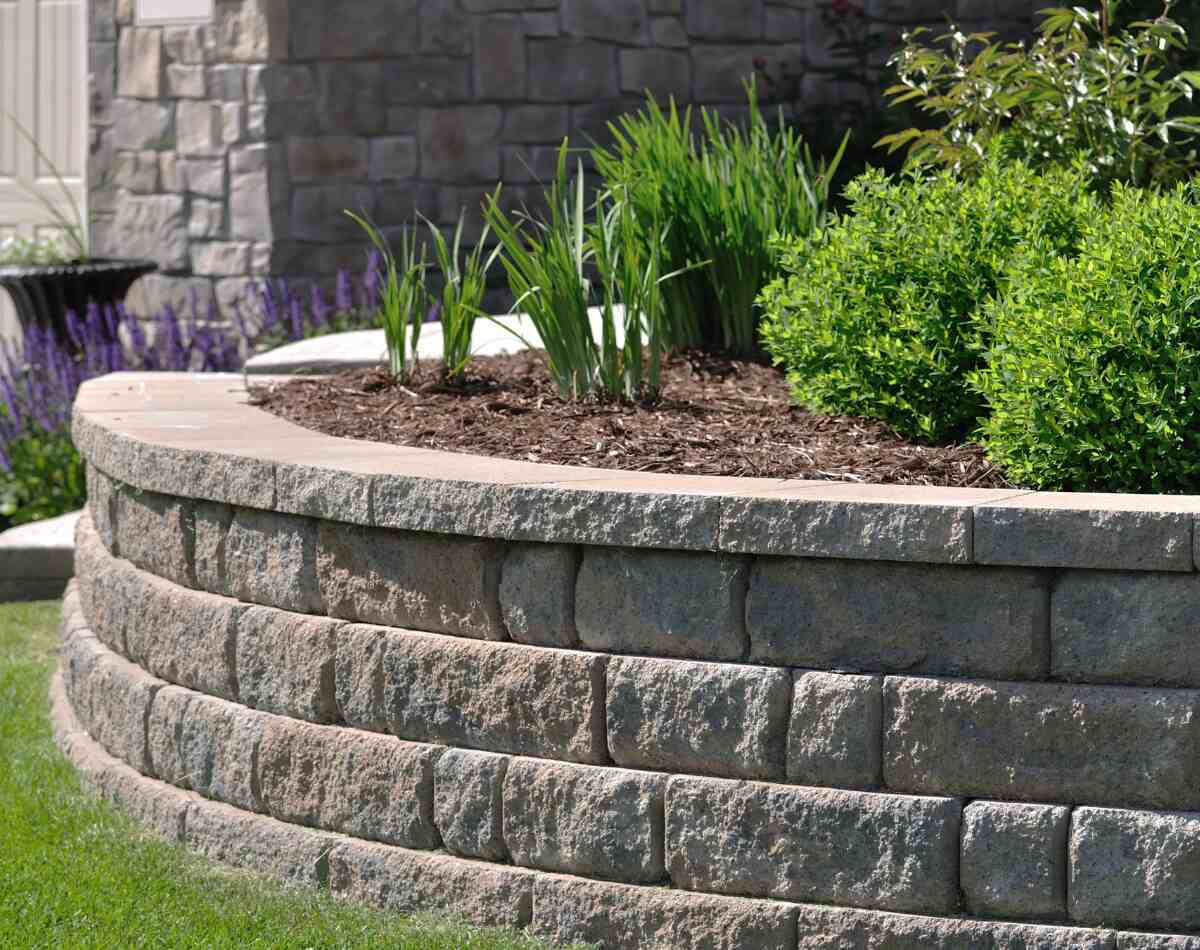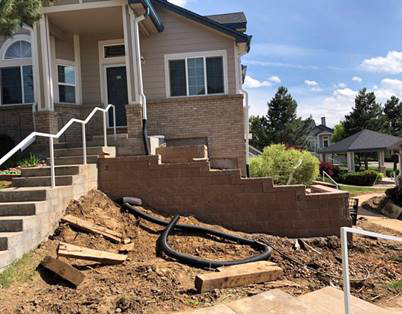OKC Precision Retaining Walls and landscape lighting: Elevating your yard’s evening appeal
OKC Precision Retaining Walls and landscape lighting: Elevating your yard’s evening appeal
Blog Article
Secret Considerations for Structure Reliable Retaining Walls in Your Backyard
When you're considering developing a keeping wall in your yard, it's crucial to assume regarding numerous crucial aspects. The wall's objective, the products you'll use, and the particular soil problems can all affect its effectiveness and longevity.
Understanding the Objective of Your Retaining Wall
When you consider constructing a preserving wall surface, consider its main objective: maintaining soil and avoiding disintegration. Retaining walls supply important support for sloped landscapes, helping to preserve dirt honesty. You'll discover they're crucial in locations where water drainage might or else clean away soil, bring about costly repair services and landscape damage.
By keeping back planet, these walls develop level surface areas for gardens, patio areas, or pathways. This not only enhances your backyard's appearances but also promotes far better water drainage, lowering water merging in unwanted areas. If you're handling steep inclines, a well-constructed retaining wall surface can avoid landslides, guaranteeing safety for you and your building.
Ultimately, recognizing the function of your retaining wall will certainly lead your style decisions and aid you create a functional, sturdy framework that satisfies your requirements. Take a minute to examine your landscape; it'll pay off in the lengthy run.
Selecting the Right Products
When choosing materials for your retaining wall surface, you'll intend to consider longevity, visual appeals, and price. Each aspect plays an essential function in guaranteeing your wall stands the examination of time while looking great and suitable your spending plan. Let's check out exactly how to make the finest choices for your project.
Product Longevity Elements
Selecting the ideal materials is important for the long life and performance of your retaining wall surface, because their sturdiness directly affects the wall's capacity to stand up to ecological stresses. Start by considering your neighborhood environment; materials like concrete and stone stand up to dampness and temperature level changes well. If you reside in an area prone to heavy rains, choose products with great drain residential or commercial properties, like gravel or permeable blocks, to avoid water build-up.
Additionally, think of the soil problems on your home. Some products carry out much better in specific soil kinds, so it's crucial to match them accordingly. Lastly, recognize potential wear from insects or disintegration. Choosing sturdy products assurances your retaining wall stands solid, securing your lawn for many years to come.
Visual Layout Selections
Durable materials not just ensure your retaining wall surface's architectural integrity yet additionally play an essential role in its visual allure. Do not fail to remember about the wall surface's shape-- curved walls can create a softer appearance, while straight lines can feel extra organized. By thoroughly selecting products that align with your visual vision, you'll enhance your outdoor room while ensuring your wall stands solid versus the components.
Cost-Effectiveness Analysis
Choosing the right materials for your retaining wall surface isn't practically visual appeals; it's additionally necessary for your budget plan. When selecting products, consider both ahead of time prices and lasting sturdiness. For circumstances, cinder block could be pricier at first, but their durability can save you cash on repair work. On the other hand, wood can be much more economical but might call for substitute earlier.
Don't forget to factor in maintenance expenses. Some materials, like all-natural stone, can add beauty and need less maintenance, while others could need normal therapies
Inevitably, weigh the benefits and drawbacks of each option versus your budget plan and the wall's desired purpose. Investing wisely in products currently can stop expensive issues in the future. Select materials that balance cost and efficiency properly.
Analyzing Dirt Conditions and Water Drainage
As you begin your task, evaluating dirt problems and water drainage is vital for the success of your retaining wall. Begin by examining the type of dirt in your lawn. Sandy dirt drains pipes well yet lacks security, while clay soil can maintain dampness, bring about press on your wall surface. Examine the soil's dampness web content by digging a little hole and observing how promptly it dries out.
Following, assess the slope of your yard. If water normally moves towards your wall surface, you'll need to implement a water drainage service to avoid disintegration and pressure build-up. Think about installing perforated pipelines or gravel backfill behind the wall surface to help with water drainage.
Lastly, observe any kind of close-by trees or greenery; their roots can impact dirt stability. By understanding your dirt problems and implementing correct drainage, you'll develop a solid structure for your retaining wall that stands the examination of time.
Following Local Building Codes
Prior to you begin developing your retaining wall, you require to study local policies to assure conformity. It's necessary to comprehend what allows you must acquire, as this can conserve you from pricey penalties or having to renovate your job. Taking these steps seriously will aid you build a safe and efficient structure.
Study Local Laws
Comprehending local regulations is important when planning your retaining wall surface project, specifically since constructing codes can differ greatly by place. Start by consulting your regional structure department or municipality to find out regarding particular demands. Look for standards on wall surface elevation, materials, water drainage systems, and structural honesty. Several locations have limitations on the types of products you can utilize and exactly how high you can build. You'll also desire to think about the zoning legislations that might influence your job. Neglecting these policies can result in costly penalties or the requirement to renovate your job. By doing your research study upfront, you can guarantee your retaining wall meets all essential codes and blends effortlessly right internet into your yard.
Obtain Needed Authorizations
As soon as you have actually researched local regulations, the following action is to get the needed permits for your retaining wall surface job. They might require details plans or engineering analyses, specifically for bigger walls. Safeguarding the best authorizations can conserve you from expensive penalties or having to dismantle your wall later on.

Preparation the Layout and Looks
As you begin intending the layout and visual appeals of your retaining wall, take into consideration exactly how it will certainly balance with the bordering landscape. Think concerning the products you'll use-- stone, brick, or concrete-- and exactly how they'll complement your home's style and the natural environments in your yard. Select colors and appearances that blend seamlessly with existing features like patio areas, paths, or yards.
Following, visualize the wall's form and height. Rounded walls can soften a rigid landscape, while straight lines might share a much more modern-day appearance. Don't fail to remember to integrate plants and plant around the wall surface for a natural touch; this can enhance its charm and integrate it right into the setting.
Last but not least, remember functionality. Your layout needs to not just be aesthetically pleasing but likewise serve its purpose effectively. By attentively planning these elements, you'll produce a preserving wall surface that boosts your yard's beauty while satisfying its structural duty.
Determining Elevation and Density Requirements
To develop Web Site a sturdy retaining wall, you require to precisely compute its height and density needs based on the dirt problems and the elevation of the incline it will certainly sustain. Beginning by assessing the incline's angle and the sort of soil, as various soils exert varying quantities of stress.
For walls over four feet high, take into consideration a thickness of at the very least 12 inches. If the wall is taller, boost the thickness proportionally to preserve stability.
Following, calculate the height of the wall by measuring the vertical distance it requires to preserve. For every single foot of height, you need to usually prepare for a density of one-third of the wall's elevation.
Constantly bear in mind to represent additional variables like water drainage and backfill, which can affect your wall surface's style. Proper computations currently guarantee your retaining wall surface stands solid and lasts for many years to find.
Maintenance and Durability Factors To Consider
While keeping your retaining wall may appear like a reduced priority, neglecting it can lead to significant problems over time. Normal inspections are essential; look for cracks, bulges, or any type of indicators of water damages. Dealing with these problems early can conserve you from costly repair work in the future.
Maintain an eye on drainage systems, also. Blocked drains pipes can cause water to develop, putting in pressure on your wall surface and compromising its stability. Clear debris and guarantee appropriate flow to keep longevity.
You may additionally intend to review sealing your wall to protect it from dampness and weathering. Depending on the product, this may need reapplication every few years.
Last but not least, landscape design around your wall surface can sustain its integrity. Stay clear of planting big trees close by, as their roots can threaten the foundation. With proactive maintenance, your retaining wall can serve you well for many years to come.

Often Asked Inquiries
Can I Construct a Retaining Wall by Myself, or Should I Work with a Professional?
You can most definitely build a keeping wall surface on your own if you have the right devices and knowledge. Hiring a professional you can check here warranties it's done properly, particularly for bigger or more complex structures. Consider your skill degree before determining.
What Are the Many Common Errors Made When Building Retaining Walls?
When developing retaining walls, you may ignore proper water drainage, skip utilizing the best materials, or neglect support. These usual mistakes can result in structural failing, so take your time and plan thoroughly to prevent problems.
Exactly how Do I Know if My Retaining Wall Demands Support?
You'll know your retaining wall requires reinforcement if you see fractures, leaning, or protruding. Check for water pooling behind it or soil erosion near the base. Address these indicators without delay to protect against more damage.
What Plant kingdom Appropriate for Landscaping Around a Retaining Wall?
When landscape design around a keeping wall surface, consider using low-maintenance plants like succulents, ornamental grasses, or sneaking ground covers - OKC Precision Retaining Walls. They'll flourish in those conditions and include beauty while protecting against dirt disintegration around your wall
Just How Can I Protect Against Disintegration Around My Retaining Wall?
To stop erosion around your retaining wall, you can grow ground cover, usage compost, and install drain systems. Consistently examine for water buildup and change landscape design to redirect overflow away from the wall surface.
Report this page